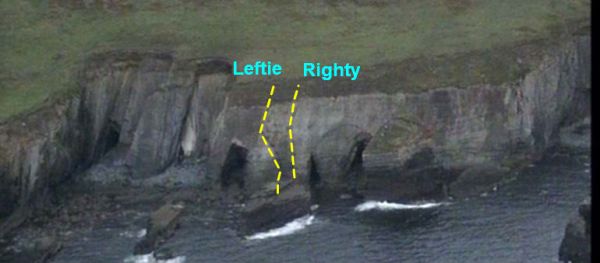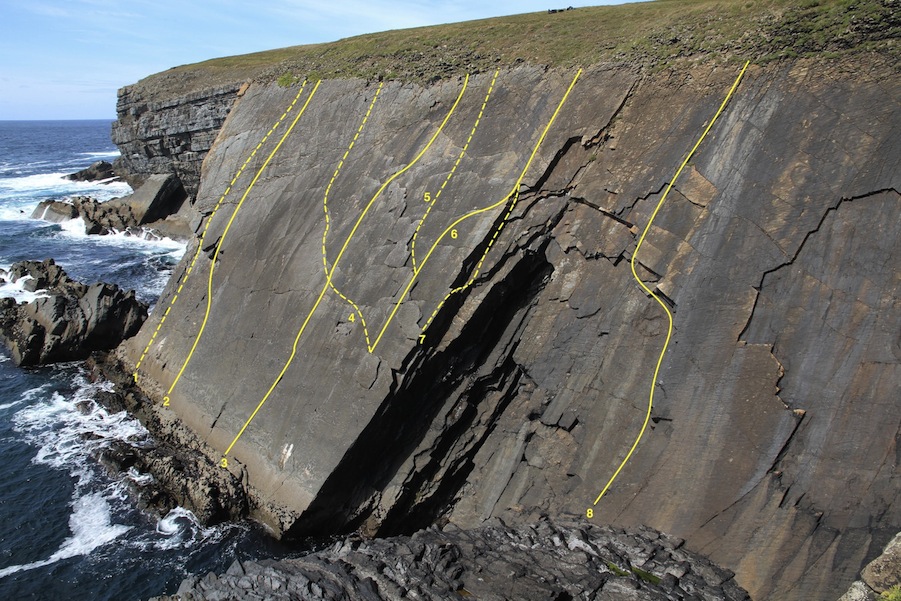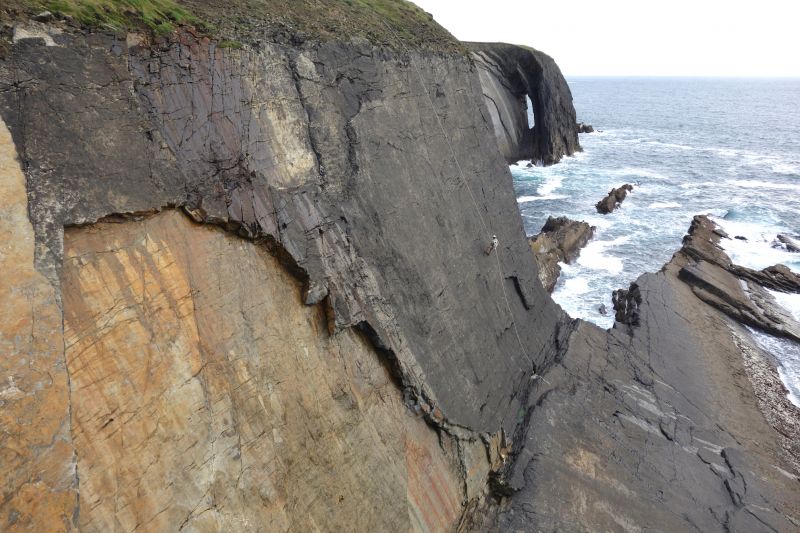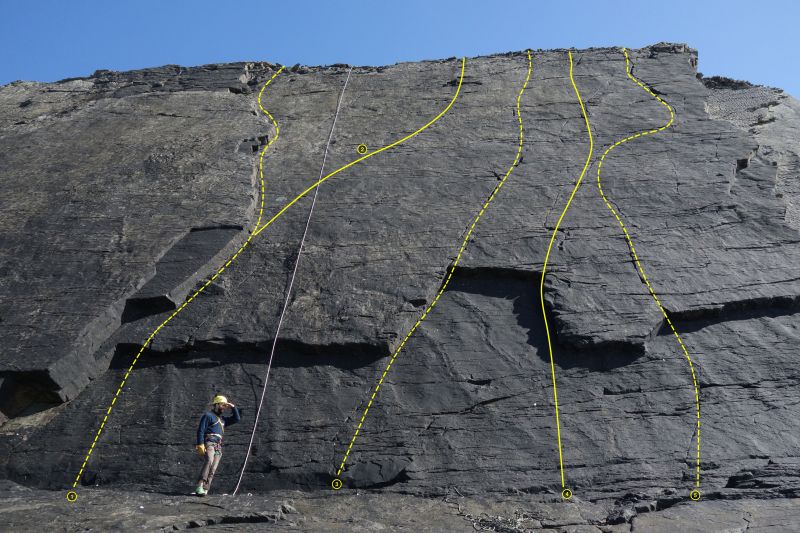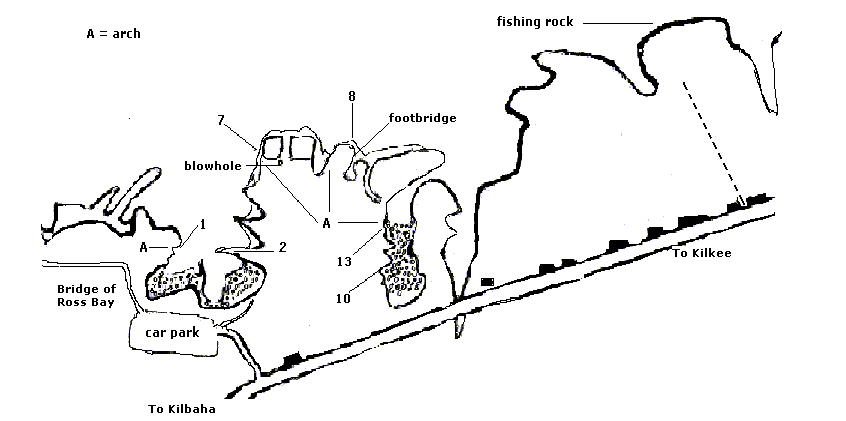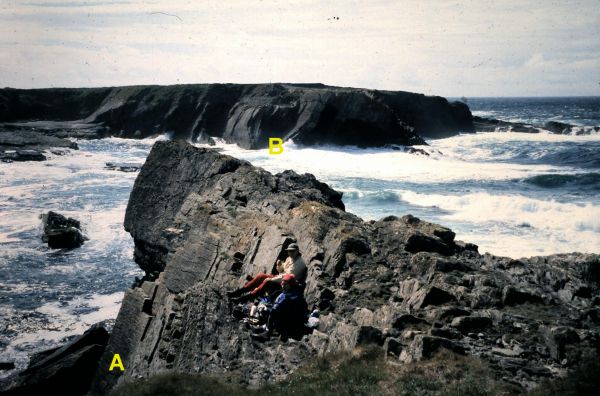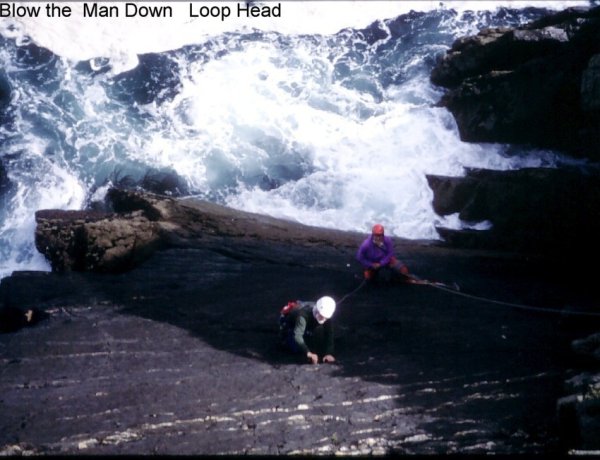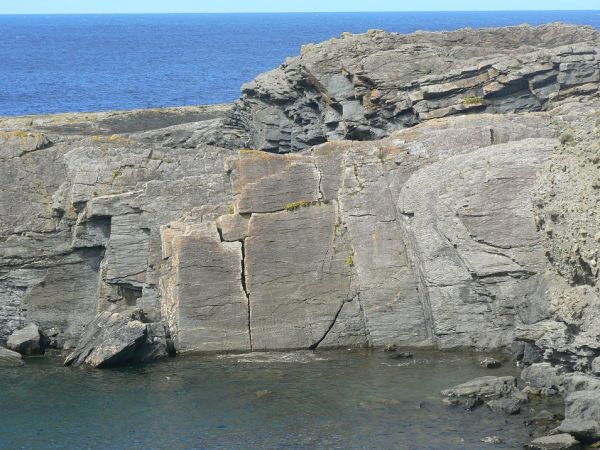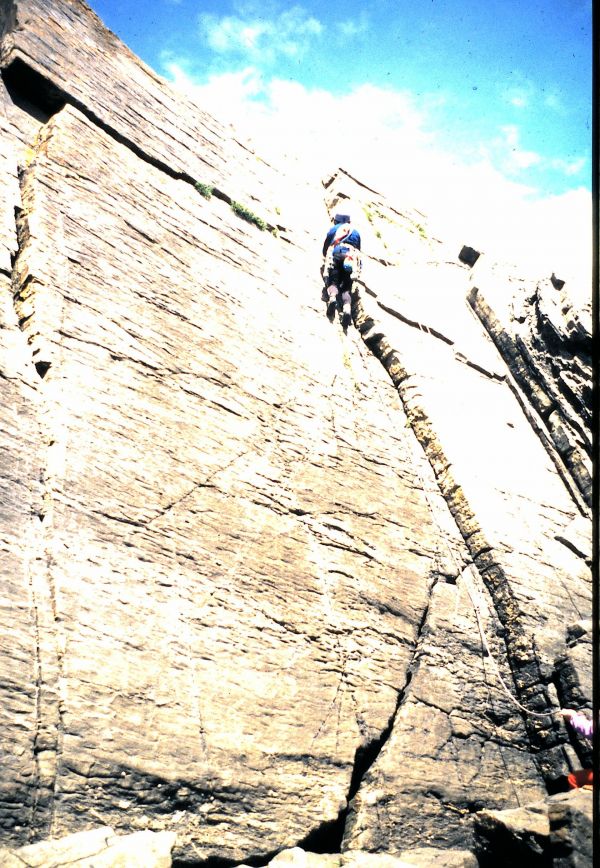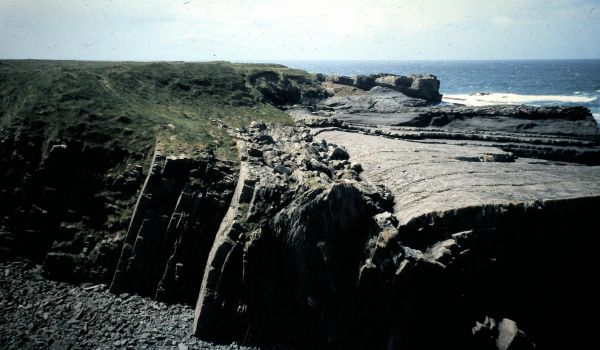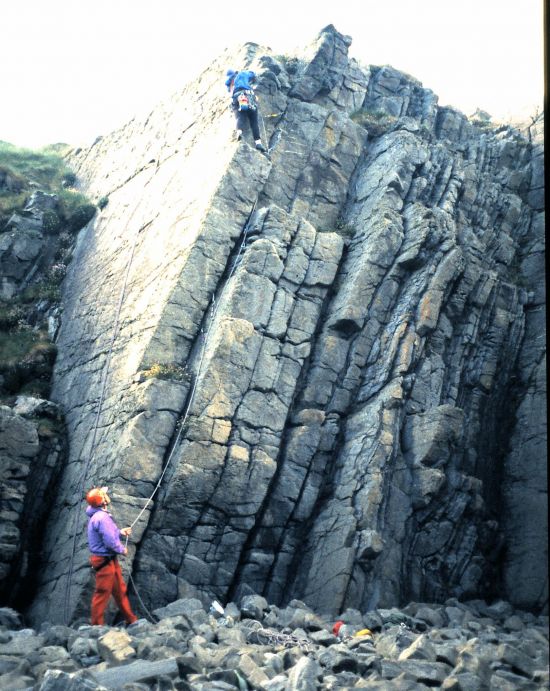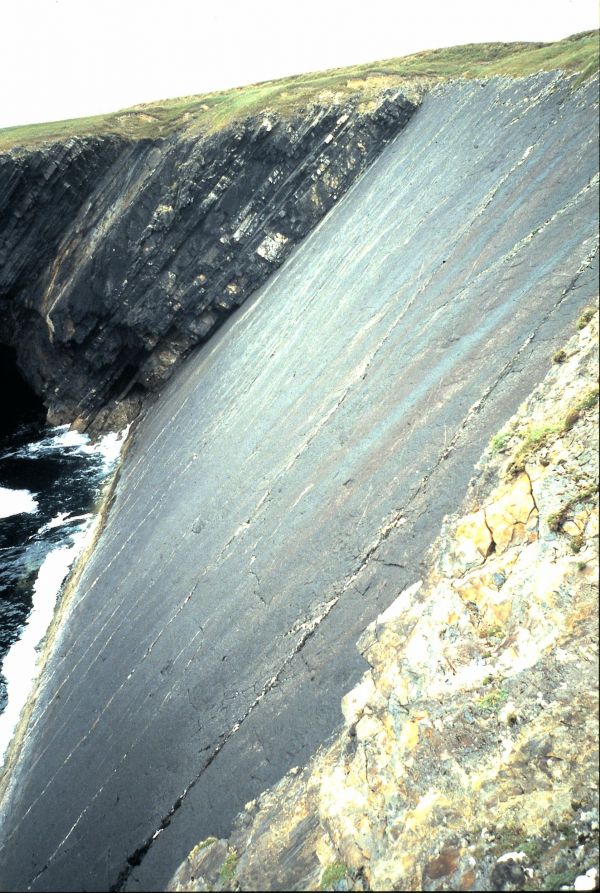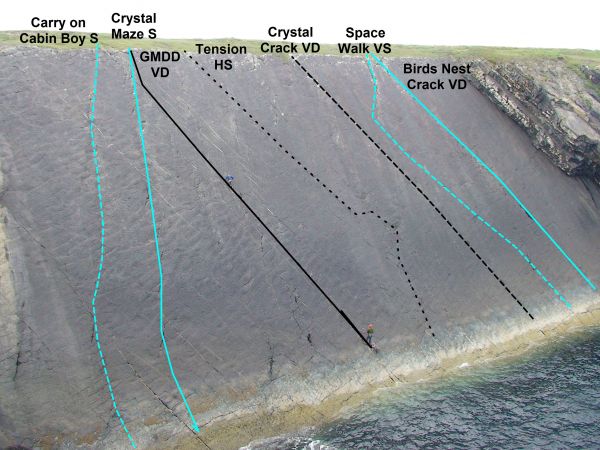Loop Head
Older climbs are taken from New Climbs 1977 and 1991
New route possibilities on this peninsula are unlimited, plenty of scope for easy slab routes and great expanses of steep serious rock for the future.
These crags are described in order, moving northeast from the Lighthouse on the tip of Loop Head (Sheet 63 OS Discovery Series, GR Q 690 472) towards Kilkee.
There is a local link bus route that links the villages Route 339 Kilrush - Loop Head to Kilrush
Loop Head Lighthouse
300m's East of the lighthouse there is a smooth slab in a large bay, the slab is opposite a large muffin-type sea stack/rock formation. There is a large cave to the left of these routes.
http://gallery.climbing.ie/displayimage.php?album=134&pid=502#top_display_media
Leftie 18m VS 4c
D Quinn, F Cox, B Watts, M Heather, 1/7/2006.
Takes the leftward trending corner
Righty 18m E1 5a
F Cox, D Quinn, M Heather, B Watts, 1/7/2006.
Takes the rightward trending corner to the ledge at three quarters height, from here a tricky move brings you onto the upper slab
As one faces the the lighthouse, follow wall around to the left to where the wall meets an old grass bank. Follow bank towards the sea, slabs 50ft on the left. Note: there are two slabs in this area. The easterly slab is located opposite a small sea arch and contains the following two routes. Abseil point to the right of slab (as one faces sea).
Janus 70ft S
Clare Sheridan, Calvin Torrans. 8th Jan 1978.
Abseil down to ledge at foot of the arete. Climb arete to top, keeping close to edge.
Slog Mhara 70ft H.S.
Dermot Somers, John Colton. 8th Jan 1978.
Abseil to small distinct ledge just right of Janus. Climb or surf directly up.
The second slab is the larger of the two and is just to the west of the smaller one. It is easily recognised by a series of small, step-like ledges (the stairs) just L of a cave and obvious fault line. Near its upper L-hand end the slab becomes steeper and is characterised by many, almost horizontal quartz veins. There are no belay stakes in situ. There is a layer of loose rock and mud at the top. This in no way impedes climbing, but rockfall, when abseiling, is a danger, so helmets should be worn. A rucksack for the climbing rope is useful, preventing it from falling into the sea.
1.Closet Entomologist 30m. VS 4c
R. Creagh, W. Dowling. 14th July 2013.
Climb the shallow L-facing corner 3m right of the arete to the overlap. Surmount this and continue up and vaguely right through the line of least resistance.
2.Foamfollower 30m. VS 4c
T. Ryan, O. Jacob, S. Gallwey. 6th December 1981.
This route takes a thin crack/overlap near the left end of the slab. Abseil down about 8m right of the left arete and belay (poor nuts/friends, and/or abseil rope) on footholds below high tide mark. Climb diagonally leftwards to a jammed block at the highest point of the overlap. Surmount this and up the thin crack crack to the steeper quartz-veined headwall. Climb straight up this to the top.
3.Selchie 30m. HVS 5a
R. Creagh, W. Dowling. 03/08/2013.
Start above the tidal rock near the centre of the slab (hanging belay in the right hand crack or stand on the ledge when tide is out.) Climb the thin cracks to the junction with Ariel and continue up towards the top of the stairs. From here step right and follow a thin crack briefly and straight to the top.
4.Ariel 25m. VS 4c
O. Jacob, T. Ryan, S. Gallwey. 6th December, 1981.
Abseil down to a small ledge below the obvious stepped ledges and about 10m above the sea. Belay on poor nuts and/or the abseil rope. In calm weather it may be possible to belay much lower down. Climb diagonally leftwards and follow the thin crack to the steeper headwall. Climb this to the top (crux).
5.Meh 20m. VS 4b
R. Creagh, W. Dowling. 03/08/2013.
Start on the same ledge as Ariel. Climb up to the stairs and left and follow a thin crack off the stairs until it ends. Climb straight to the top.
6.Foam Flock 20m. HVS 5a
R. Creagh, W. Dowling. 31/07/2013.
Start as for Ariel. Climb straight up to the stairs and follow the thin crack above until the second horizontal break. Follow this out right to the arete and finish up the broken crack, watching out for loose blocks in the crack.
7.Dimensions 20m. VS 4c
R. Creagh, W. Dowling. 03/08/2013.
Start at the bottom of the stairs. Climb up to a flat hold on the arete and step around into the corner. Climb this until you can gain the broken crack of Foam Flock. Rock is a bit flaky but manageable.
8.Lost and Found 30m. HVS 5a
R. Creagh, W. Dowling. 12/08/2013.
This route starts R of the cave. Start up the obvious L-facing black corner and follow this to where it becomes an overlap. Traverse left until a crack above allows access past the overlap. Finish up the overlap.
Diarmuid & Grainne's Rock
Dermot and Gráinne's Rock 60m XS
M. Fowler, S. Sustad (alternate leads) June 1990.
This fine stack (aka Oileán na Léime)is separated from Loop Head by a long, deep and atmospheric channel. Abseil (Note: The bumper of a parked car was used as abseil anchor - Ed.) into the chasm at its northern end and swim across to gain a ledge 50m from the Kilkee (north) end of the stack. Crawl along the incut ledge about 10m above the high water mark (very slippery and 5a at one point) to gain ledges at the Kilkee end. Move up to a higher ledge and belay.
1) 10m Traverse around the corner onto the seaward side of the stack and climb a chimney/corner to gain a projecting ledge on the right.(In calm weather it would be possible to walk round to beneath the seaward face on an exposed ledge system).
2) 10m 5b/c Traverse 15m right to gain good handholds on an overhanging wall which is climbed to gain ledges leading left to beneath a steep shallow groove. Climb this and exit left at the top onto ledges. Make a couple of moves up a thin crack just right of the arete to gain a good ledge on the Kilkee (N) arete. 10m higher is another good ledge.
3) 16m 5a Climb the right-hand side of the arete to gain an obvious ledge which crosses the landward side of the stack at 2/3 height. Move right-wards along the ledge to the seaward corner where it abruptly ends.
4) 24m 5b/c Hand traverse 15m right(onto seaward side) and pull up onto projecting footholds. Surmount the overhanging projections above and trend right up shallow grooves and a wide crack to a good ledge 10m below the top. Finish on the right.
Return by "Tyrolean"
On the north side of Loop Head, some 200 yds east of the lighthouse and Dermot and Grania's rock, a series of impressive steep smooth integral shaped slabs will be seen. Climbing on these cliffs is extremely serious, due to their remote position, exposure to the Atlantic and nature of the rock. An accident, no matter how trivial, would become a very serious matter.
Black Space 200ft HVS
S. R. Young, P. Brennan 4th Sept 1977
This line takes the corner at the end of the slabs and the start was reached by abseil down the route. Obvious loose material was cleaned out.
1) 100ft. From the sea-washed platform (using ab rope as belay anchor) climb the overhanging corner until the angle eases, plenty of doubtful protection, belay in niche.
2) 100ft. Continue up the corner in an extremely airy position until very loose rock and earth is reached. From this point on the abseil rope was used for aid for the final 30ft.
Further east along Loop Head is the Trevor Elliot Slab. About twenty minutes from the car park, the crag is situated in a right angled bay south of Black Rock, facing north. There are no natural anchors above the crag so stakes are required to abseil in. It's best to arrange an abseil rope in the centre of the slab as this will reduce the need to put the stakes in a new position for belaying, having topped out each route. There is a large ledge at the bottom of the crag which isn't tidal, but a big swell could impede climbers. The rock quality is good, being more compact than the slabs south of Loop Head lighthouse, with better protection. Be careful with blocks embedded in the top of the cliff when topping out.
1. No Smoke Without Fire 20m. VS 4c
R. Creagh, W. Dowling. 10/08/2015
The obvious line of the crag, taking the right facing corner that leans right and then left. Worth a go.
2. Wimmin and Biscuits 22m. HVS 5a
R. Creagh, J. Nicol. 15/08/2015
Start up No Smoke... and continue up and right where the main corner starts to lean left. The route follows thin cracks and horizontal breaks, offering lovely sustained slab climbing.
3. Floodgate of Love 20m. HVS 5a
R. Creagh, W. Dowling. 10/08/2015
A superb route. Start up the left corner of the incut alcove and continue up thin cracks. The seam peters out near the top but holds and gear appear as you need them.
4. Second Chance 20m. E1 5b?
R. Creagh, J. Nicol. 15/08/2015
Start up the right corner of the incut alcove and continue up along thin cracks to where they close up. Keep the faith and forge upwards, moving slightly right and slightly left where necessary to a final tricky move below the top. Unfortunately, due to stormy conditions, the onset of darkness and a questionable belayer, the leader opted to escape left instead of doing the final move, so this route still needs a real ascent. It's great to here.
5. Brendan the Wasp 20m. HVS 5a
R. Creagh, J. Nicol. 06/08/201
Climb to a crack that meets the overlap and continue up it until a delicate traverse right brings you (nearly) within reach of the widening crack that reaches the top. A final tricky section lands you in the crack, where you can handjam your way to victory.
Bridge of Ross Bay GR Q 735 504
The area is described from W to E and the climbs from left to right when viewed from below. The first two slabs are easily spotted, being on either side of the little bay immediately in front of the car park, which is signposted.
On the west side of Bridge of Ross bay there is a slab forming the left side of an arch. The slab has a diagonal crack in its lower section, two corners on the upper left hand side and a short, steep wall at the top. Abseil down to a belay in the diagonal crack, at a point where there is a blow hole running through to the arch: an atmospheric place when the seas are surging in. (Low to half tide only).
BLOW THE MAN DOWN V.Diff
G. Moss E. Hackett , L. Convery 5/6/99
Climb diagonally right to gain the edge and finish up the overhang on good holds.
BAY SLABS. Half to low tide. These are the slabs jutting out into the bay on the E side. Approach by boulder hopping from the foot of the slipway at the back of the bay, or by abseil.
CRYSTALLOGRAPHER'S DELIGHT S
L.Convery G. Moss E. Hackett 5/6/99
The left side of the slab has an overhanging band running across it at about 4m. Start below a crackline in the centre of the upper section. Climb steeply to the overhang and follow the crack above.
THE GIFT S
Féidhlim Harty, Eimear Duggan 27/6/09
The climb is located half way between Crystallographer's Delight and Meehan's Corner. Start the climb below the small vertical crack and follow the crack to the top.
MEEHAN'S CORNER Diff
E. Hackett L. Convery G. Moss 5/6/99
Start 3m right of 2, below the obvious left-facing corner.
Climb the arête on the right side of the corner and the short wall above.
LITTLE BRO. HS.
G.Moss. H Herzmann. 14/4/07
Climbs the short steep slab to the L of Stonechat.
STONECHAT V.Diff
L.Convery E. Hackett G. Moss 5/6/99
Start at the foot of the wide crack. Climb the crack, stepping right to finish.
ROCK PIPIT HS
G. Moss L. Convery E. Hackett 5/6/99
Climb the slab to the right of the crack.
SPRING BREAK VS 4c
N McGreen, B Watts, 24/4/2016
Climb the wall left of THE LITTLE ARK past a no of horizontal breaks to the top, difficulty increasing with height.
THE LITTLE ARK S
E. Hackett L. Convery G. Moss 5/6/99
Climb the shallow left facing corner to the right of Rock Pippit.
SQUARE BUTTRESS 1.
There are two obvious square-cut, flat-topped buttresses on the east tip of the Bridge of Ross bay. These climbs are on the west facing wall of the west buttress. Access to the foot of the wall is by abseil (low to half tide only). Due to tidal restrictions only one route was done on this wall, but there are a number of steeper possibilities.
ESCAPE ROUTE Diff
Start below a groove at the right end of the wall. Climb steeply on large holds until it is possible to move right to a large ledge. Continue more easily to the top
Footbridge Buttress.
The following climbs are approached by crossing a small, natural footbridge of black rock, spanning a channel about 2m wide. Access to the footbridge can be gained by scrambling down some 30m to the east and traversing back along the shoreline or by abseil. (Low to half tide only). From the footbridge move 3m right to the foot of a black groove.
COAL CORNER Diff
Climb the groove.
E. Hackett L. Convery 7/6/99
BROINGLOID NA GCAPAILLINI BÁNA V.Diff
Climb the steep, exposed arête on the right of the groove, on good holds.
L. Convery E. Hackett 7/6/99
Little Zawn
About 50m east of B.O.R bay. Approach by a steep grassy track at the back of the zawn. With the exception of the last climb all the routes here are non-tidal. On the W side of the zawn are two steep slabs, the first route is on the left slab.
LOOPLINE VS 4c
G. Moss L. Convery E. Hackett 6/6/99
Start at the bottom right of the slab and trend slightly left to finish up the centre.
MONEEN CRACK S
E. Hackett L. Convery G. Moss 6/6/99
Start just around to the right of Loopline, below the corner/crack line. Climb this to the top.
SMURF FOOT Severe
Ciarán Campbell, John Edwards. 4/6/2014
Start 2m to the right of Moneen Crack, follow the obvious crack line. Protection is poor. Be careful of loose rock.
ROS NA RÚN VS 4b
G. Moss L. Convery E. Hackett 6/6/99
Start at the foot of the second slab. A steep start leads to a pleasant finish.
NOAH ROCKS Severe
John Edwards, Ciarán Campbell 4/6/2014
Start around the corner from ros na run, follow the obvious crack line to a small ledge at 2/3 up. step around to the left, traverse to join the final stages of ros na run.
MOSS BRIDGES HS
L. Convery E. Hackett G. Moss 6/6/99
Start on boulders just left of the mouth of the huge arch (most tides). Climb the arête on large holds until it is possible to make an airy and thought-provoking traverse out right over the edge of the void, go around a rib and finish up the short corner.
CRYSTAL CLAMBER HS
Ciarán Campbell. John Edwards. 4/6/2014
The small slab on the east side of little Zawn. Approx 5m high, directly opposite"Moneen Crack". Protection is poor until you reach a horizontal crack approx 2/3rds way up. No protection after this making the last move airy. Climb directly up the face of the slab without using the edges for holds.
Steve's Slab GR Q 777 523
This magnificent, easy angled sea slab is probably unique in Ireland and is well worth a visit.
Approach. The original approach, as described in 1977, included the crossing of some fields, not an option these days. Luckily, recent developments have helped to provide a straightforward, trouble-free approach. Traveling southwest from Kilkee on the R487, drive through the little village of Cross, then, about a kilometre beyond the cemetery, turn right at a staggered crossroads (GR 782 511) onto a narrow road, which is surfaced for the first 200m and then badly potholed and unsurfaced.. After nearly a kilometer a new section of this road swings left (west) to arrive at a disused quarry. There is ample parking here. A pleasant walk of 15 - 20 minutes, along a narrow path, with the cliffs on your right and the field boundaries on your left, will bring you to the slab, which has been likened to an inclined hard-surfaced tennis court, with a cave at its eastern end (right, facing out). The top of the slab is level with the path and only 2 or 3 meters away from it. There are good belays, holds and gear placements especially small threads in the cracks, and the higher you climb, the better the friction becomes. The foot of the slab is reached by an abseil of almost 50 meters, there are no metal stakes in situ (Note: there are no ledges at the foot of the climbs, belay from nuts or friends in the cracks). The climbs are described from right to left as seen facing out to sea from the top of the slab.
Carry On Cabin Boy S
B Watts, N McGreen, 23/4/2016
Abseil down to a stance 5m right of the corner and left of a vertical quartz vein.
Climb up a series of herringbone cracks to reach the quartz vein, the quartz vein heads leftwards /eastwards, ignore this and head slightly rightwards/westwards to the top, the last 8m’s are on small friction holds.
Crystal Maze S
Peter Wood, Barry Watts, 31/7/2016
Belay above the water about 10m right of the corner. Climb the initial slab delicately to reach and follow a line of quartz veins and short herringbone cracks which join Greedy McGreen’s Downhill Derby to finish.
Greedy McGreen’s Downhill Derby VD
Niamh McGreen, Barry Watts, 23/4/2016
Takes the prominent left-trending quartz crack,approximately 20m right of the corner.
Tension. HS
S. R. Young, J. Leonard. 27th August, 1977.
This climb is described as starting from a slight circular recess, but this is difficult to see from above. Start below and left of this recess on a short crack that runs for approximately 10m to the reces. At the recess move up on a crack for 2-3m only before stepping left delicately across slab to to gain the left hand leftward-trending crack.
Crystal Crack. V. Diff.
J. Leonard, S.R. Young 27th Aug 1977.
This quartzite crack starts near the bottom centre and runs up diagonally eastward.
Space Walk VS 4b
Gerry Galligan, Barry Watts, 30/7/2016
An ill-defined route that links short cracks, scoops and pock marks, to offer bold and delicate slab climbing between Crystal Crack and Bird’s Nest Crack.Protection is good but often spaced.
Belay at the base of an 10m vertical crack, approximately 8m to the right of Crystal Crack. Move to the top of this crack before traversing left up to a good horizontal break. Continue up to a semi-circular scoop. Traverse right to gain another scoop before switching left to reach a right-trending quartz crack. (Alternatively, aim for this crack directly from first scoop). Follow the quartz crack to finish.
Bird Nest Crack. V. Diff.
This is the easiest climb on the slab and takes the wide quartzite crack on the right.
J. Leonard, S.R. Young 27th Aug 1977.
Niamh’s Slab
An impressive 40m high slab 250m East of Steve’s slab, which is closer to the access road. Approach as for Steve's slab. There is a large ledge/platform running centrally across half the base of the slab. The slate rock is rougher and more featured than Steve’s Slab but is almost devoid of usable cracks and protection is very limited. There are no clearly defined or prominent lines. The top of the slab contains loose holds and care is needed. Two routes recorded to date:
Bouncy Cattle S
Gerry Galligan, Barry Watts, 30/7/2016
Start at the left end of the platform. Move up, trending slightly leftwards on good holds to finish. Enjoyable climbing, despite poor protection.
Haymaker S
Barry Watts, Gerry Galligan, 30/7/2016
Climbs central line to the large niche at two third height. Follow the slab on the right and finish diagonally leftwards.
Croan Rock Gr 784 538
Approach: Just before entering the village of Cross on the R487 turn right at a crossroads. Continue along this lane and go left at the first turning. Follow the road by farms until a slabby ridge can be seen off to the right (after one mile) . Leave the car at the barn and walk across fields leading down to a cove.(Note: sheet 63 shows a path leading from the end of the road to the cove - Ed.).
The first obvious slabby ridge is Green Slabs,and just beyond this, across a narrow zawn ending in a sea cave, lies another ridge with Pale Slabs and beyond the tip of that another ridge consisting of Black Slabs.
Cross the river and walk along the cliff top until the Pale Slabs ridge is reached. Descend from the ridge by abseil to the obvious ledge about 15ft above sea level.
Puffin' 150ft. V.D.
S. R. Young, D. O'Murchu 23rd Oct 1976
Climb the obvious corner at the land end of the slab, via the bulge to the top.
Pullin' 150ft S
S.R. Young, D. O'Murchu. 23rd Oct 1976
Climb the approximate centre of the slab on good holds with excellent protection.
Punchin' 80ft Diff
D. O'Murchu, S. R. Young 23 Oct 1976
Climb the seaward edge of the slab.
Illaunonearaun Slabs Gr 833 568
These "circular slabs lie opposite the flat-topped island, Illaunonearaun, and are just below the road. The slabs are in two sections, and all routes so far are on the easterly section. (Unfortunately, the slabs proximity to the road has resulted in them being used as a rubbish chute - dumping refuse off cliff tops is a popular local custom). Access by scrambling down on either side.
Finger Lick'n Crack. 50ft VS
S. R. Young, J. Leonard. 28th August 1977.
This route climbs the second corner running up the slab - the narrow cracked corner. From the top of the corner continue up the crack to the top.
Ethereal 180 ft. VS
S. R. Young, P. Brennan. 3rd Sept 1977.
About mid-way between Finger Lick'n Crack and Black Bottom a vague line of weakness runs up diagonally R. No description is necessary, protection is extremely poor, beware of broken glass.
Black Bottom 180 ft S
J. Leonard, S. R. Young 28th August, 1977.
About 50ft west of Finger Lick'n Crack, the route follows the only line of weakness up the infinitely varying angled slab, trending R. Beware of broken glass, climbed in two pitches due to lacerated leader.
Beyond Black Bottom the slabs may be ascended as one pleases at grade of Diff. - V. Diff.
The second section of slabs are generally featureless, no routes as yet.
